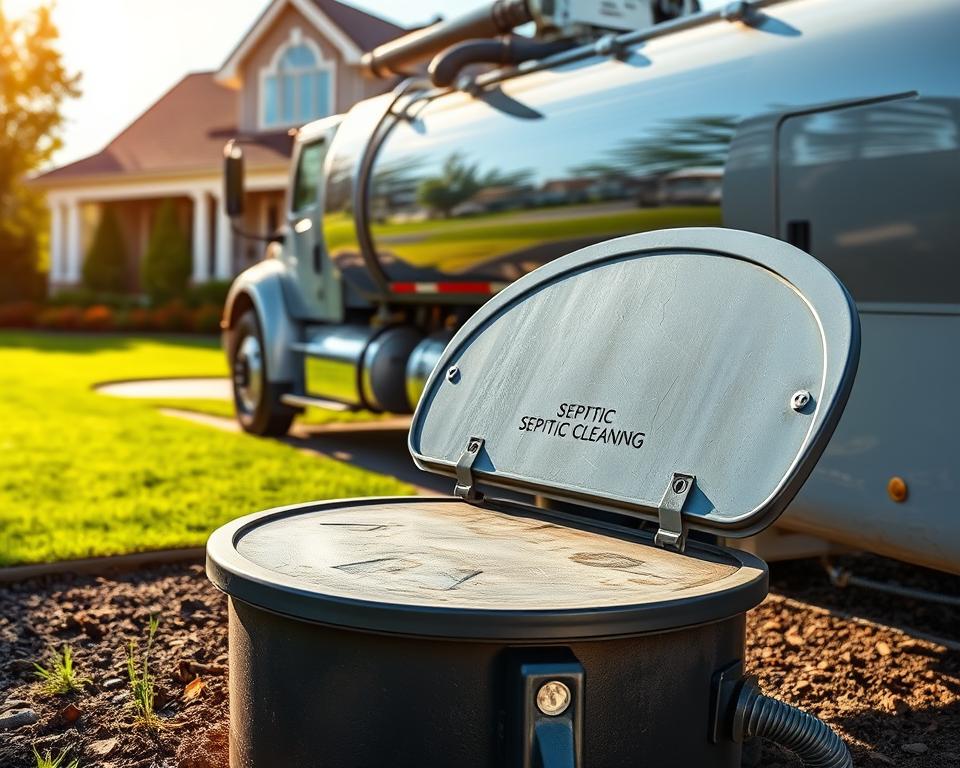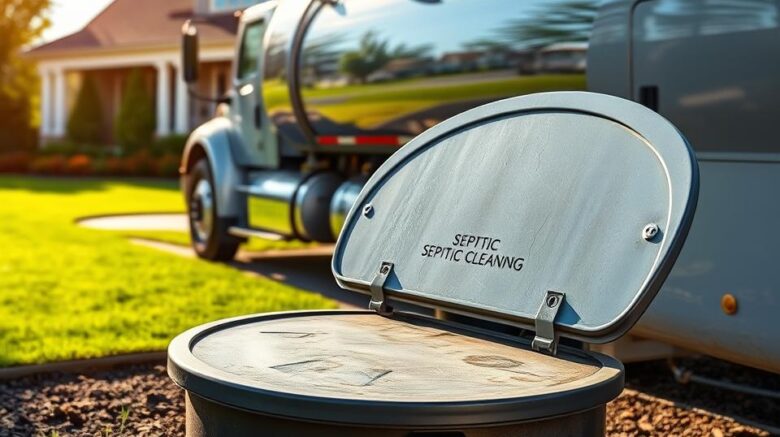Septic Tank Inspection Cost: Your Guide
Curious about the cost of a septic tank inspection or how it could save you money in the long run? It’s key for homeowners to know the price of inspecting their septic system, particularly when considering health risks and property value. It’s vital to understand the factors impacting septic tank inspection costs and associated service rates. An expert like All in Sanitation can provide critical local knowledge and assist in keeping your septic system up to par – septic system inspection.
Fundamental Insights
- Understanding septic tank inspection costs can help prevent unexpected expenses.
- Valuable support for homeowners is offered by local experts such as All in Sanitation.
- Maintaining property value requires essential regular inspections.
- Varying cost factors can impact inspection prices.
- Keeping abreast of inspection service rates is key to effective maintenance.
Why Septic Tank Inspections Are Important Septic Tank Inspections
Essential for homeowners, especially in rural areas, are septic tank inspections. Ensuring septic systems work well and meet health guidelines is their purpose. Expensive repairs and environmental risks can result from skipping these.
Homeownership goes beyond basic upkeep. A septic system that runs smoothly improves comfort and protects environmental health. It prevents water source pollution and decreases public health threats.
Regular checks help identify small issues before they worsen. Protecting property values and family health is a result of this proactive approach. Investing in routine septic inspections is therefore beneficial. It offers comfort and a dependable sanitation option.
| Benefit | Description |
|---|---|
| Cost Prevention | Early detection of issues prevents costly repairs in the future. |
| Health Safety | Ensures that septic systems do not contaminate drinking water. |
| Environmental Protection | Maintains the health of surrounding ecosystems by preventing leaks. |
| Compliance | Meets state and local health regulations to avoid fines. |
| Property Value | Well-maintained systems can improve the value of real estate. |

A Septic Inspection Explained
Revealing what goes into evaluating a septic system is an overview of a septic inspection. It typically includes an in-depth check of the septic tank, drainage field, and pipes. Avoiding expensive fixes or dangerous conditions is possible as this extensive review allows homeowners to spot potential problems early.
Experts focus on key areas when performing a septic tank check-up. These areas include:
- Checking for any signs of leaks or water pooling near the tank.
- Measuring sludge levels to figure out tank capacity.
- Assessing how well the drainage field is working.
- Checking the overall condition of the pipes and connections.
For the septic system to work properly, each part is essential. The goal of the inspection is to identify areas that require attention. Safeguarding the system’s performance and increasing its lifespan are results of conducting regular checks. Therefore, these evaluations are critical for keeping up with property maintenance.
Factors Influencing Septic Tank Inspection Costs
It is crucial for homeowners to understand the elements influencing septic inspection costs. Various elements impact septic inspection pricing, leading to a wide range of septic inspection expenses.
Location is one significant factor. High-demand areas might see increased prices. The septic system type, be it conventional or alternative, also affects the cost. Raising the inspection fees is a result of complex systems demanding more expertise.
Accessibility is key as well. Hard-to-reach tanks necessitate additional labor, bumping up the price. Extra services, like soil tests or tank pumping, further inflate the cost.
| Factor | Impact on Cost |
|---|---|
| Location | Higher prices in urban areas; lower in rural zones |
| Type of System | Conventional systems cost less; advanced systems more |
| Accessibility | Hard-to-reach tanks may increase labor costs |
| Additional Services | Soil tests and pumping add to overall pricing |
These factors are crucial in shaping expenses for septic inspections. Anticipating septic tank inspection costs effectively is helped by being aware.
Typical Cost for Septic Tank Inspections
Knowing the average cost of a septic tank inspection is essential for homeowners. Between $100 and $900 is the usual price range. Largely depending on the inspection type is this variance. While in-depth analyses or those requiring digging are costlier, basic visual checks are more affordable.
The table below shows the different inspection types and their associated price ranges:
| Type of Inspection | Cost Range |
|---|---|
| Basic Visual Check | $100 – $300 |
| Comprehensive Assessment | $300 – $600 |
| Excavation Required | $600 – $900 |
Offering septic inspection services at competitive rates is how All in Sanitation sets itself apart. Accommodating various budgets, it provides great value. Crucial is knowing the typical charges for septic evaluations. It aids homeowners in making well-informed decisions about system upkeep and overall functionality.
When Do You Need a Septic Tank Inspection?
Knowing when to obtain septic inspections is crucial for maintaining a home properly. During key moments, such as before a property transaction, it’s vital. A quick check can uncover problems that affect the property’s value or result in expensive repairs.
Do not ignore plumbing signs that signal a septic issue. Slow drains or odd smells suggest problems. Addressing these signs quickly with an inspection prevents worse issues. Functioning properly is maintained for your plumbing by it.
Awareness of local septic inspection regulations is important. Ensuring you comply is done by knowing your area’s rules. Depending on household size and usage patterns, aim for inspections every 1 to 3 years. This schedule serves as a good baseline.
Being informed about when to get septic inspections helps ensure your system works effectively. It protects both your home and your financial investment.
A Septic Tank Inspection: Step-by-Step
The septic tank inspection involves key steps ensuring your system’s safety and functionality. Homeowners can be more ready and informed by knowing what occurs during an inspection.
Starting the inspection is a detailed site review. This involves checking the area around the tank, identifying any hazards, and ensuring the site is prepared for the inspection.
Checking the tank’s condition is done by the inspector after reviewing the site. Checking the tank walls and lid, they look for any damage or wear. They also assess sludge levels to see if pumping of the tank is needed.
A crucial final step involves leak detection. The inspector looks for leaks to identify problems with the tank or drain field. This complete review helps homeowners tackle issues and keep their system in good condition.
Length of a Septic Tank Inspection
Septic inspections typically last from one to three hours. This variation is dependent on the size and complexity of the system. For larger or more intricate systems, the evaluation could take significantly longer.
Helping homeowners prepare is understanding the timing of the inspection. Being present during this process enables direct communication with the inspector. This interaction provides an opportunity to learn about maintenance, identify potential issues, and confirm compliance with standards.
Adequately scheduling time for the inspection helps ensure it is comprehensive. It also provides an opportunity to address any concerns. Always engage qualified professionals for an accurate evaluation tailored to your specific situation.
Understanding Septic Tank Inspection Cost Details
For homeowners wanting to evaluate or maintain their systems, grasping the septic inspection cost is critical. Impacting the price, each inspection type serves a unique purpose and involves varying expertise levels.
Typically, these inspections are categorized as follows:
- Visual Inspection: A basic evaluation of the system’s visible parts, priced between $100 to $200.
- Basic Inspection: Costing between $200 and $400, this goes beyond visual checks, testing system components and function.
- Full Examination: The most detailed form of inspection. It includes tank pumping, drain field inspection, and the use of specialized equipment. Prices range from $400 to over $1,000, based on system size and complexity.
When budgeting for a septic inspection, it is wise to consider potential additional costs for services or repairs. A complete guide to septic system pricing aids homeowners in preparing for these expenditures, ensuring the maintenance of a functioning system and averting expensive breakdowns later.
Common Causes of Septic Tank Inspection Failure
Resulting in septic tank inspection failures are several common issues. Each problem can lead to expensive repairs and significant health risks. To keep systems in top condition, it’s crucial for homeowners to understand why inspections fail.
Often, routine maintenance is overlooked, which leads to system decay. Sludge buildup that is ignored due to infrequent inspections causes overloads and backups. Homeowners need to schedule regular checks to avoid these issues.
System design errors can also cause failure. If the tank is too small, it won’t handle household waste well. Incorrectly laid pipes can obstruct proper drainage, making matters worse.
Septic system function is significantly affected by environmental conditions. Heavy rainfall can swamp the system, which improves the chances of an inspection failure. Similarly, trees planted too near drain fields can send roots that damage the system.
The financial repercussions of failing a septic tank inspection are substantial. Repairing or replacing parts can range in cost from a few hundred to thousands of dollars. Highlighting the vital need for regular maintenance and inspections is done by this.
Who Can Conduct a Septic Tank Inspection?
Key is choosing the right expert for septic tank inspection. Only certified septic inspectors have the necessary expertise for this task. They understand local regulations and make sure your septic system meets the required standards.
Certified professionals at companies like All in Sanitation perform thorough evaluations. Training to spot potential problems early is part of their expertise. Offering homeowners confidence in their systems and meeting regulatory standards is a dual benefit of this.
Checking the qualifications and experience of any inspector is crucial. Look for reviews to assess their reliability and attention to detail. Hiring someone without the right qualifications could mean missing crucial issues, leading to expensive repairs later.
Extra Advice for Septic System Care
To avoid expensive repairs, maintaining a septic system is crucial. A few practical tips can greatly improve its life. Regular pumping, every three to five years, prevents sludge from accumulating. This helps keep the system running smoothly.
Also vital is choosing the right household products. Harsh chemicals harm the bacteria that break down waste. Biodegradable and eco-friendly options should be opted for.
Septic treatment products improve healthy bacteria levels, which assists in the efficient breakdown of solids. This balance is essential for the system’s effectiveness.
These maintenance tactics can help reduce inspection costs over the long run. A well-cared-for system seldom requires costly fixes. Offering peace of mind and ensuring seamless operation are benefits of these proactive measures.
In Summary
Understanding the costs associated with septic inspections is crucial. This comprehension highlights the essential nature of investing in upkeep to prevent larger problems. By maintaining your system regularly, you avoid spending more time and money later.
Septic maintenance is vital for keeping your home safe and operational. Protecting the environment and improving your property’s value are benefits of a well-kept system. You avoid expensive repairs and prolong your system’s life by conducting regular checks and addressing issues early.
Key is focusing on proactive management of septic inspections, in closing. If you have not yet scheduled an inspection, now is the time to reach out to a professional such as All in Sanitation. Taking these proactive steps ensures the longevity and efficiency of your septic system, offering you peace of mind.
